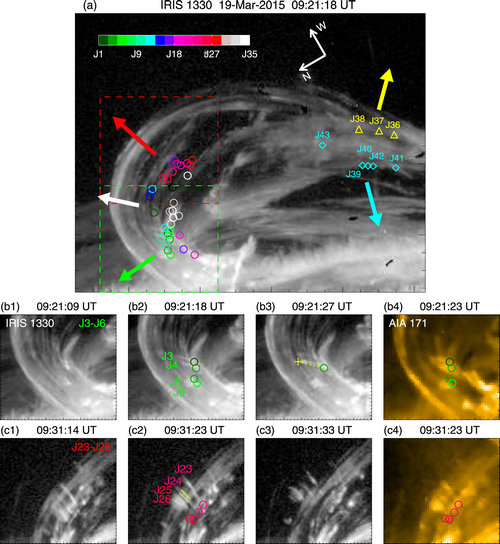Solar jet is a common activity phenomenon in the solar atmosphere. It mainly appears as transient collimated plasma ejections. Some studies have shown that jets may play an important role in heating corona and initiating solar winds. By using space observations from the Interface Region Imaging Spectrometer (IRIS) and the Solar Dynamics Observatory (SDO), Dr. Huadong Chen at National Astronomical Observatories of Chinese Academy of Sciences (NAOC) and his collaborators first find a particular type of small-scale jets, which arose singly or in clusters from a tornado-like prominence suspended in the corona (Figure 1). The difference in the local plasma environment and magnetic field topology structure between these coronal mini-jets and the other jets previously reported suggests that they may have different formation mechanisms. The research result has been published on The Astrophysical Journal Letters in May 2017.
Recently, the international research team, led by Dr. Huadong Chen, together with Prof. Jun Zhang of Anhui University, Dr. Bart De Pontieu at Lockheed Martin Solar and Astrophysics Laboratory of USA, Dr. Suli Ma at NAOC, Dr. Bernhard Kliem from University of Potsdam of Germany, and Prof. Eric Priest at University of St Andrews of UK, further performs a statistical analysis of the dynamical and energetic characteristics of the coronal mini-jets. Based on the relevant observational features, such as the acceleration of the jets, the UV and EUV brightenings at the jets’ footpoints, and the activation and disturbance of the host prominence, they proposed two possible fine-scale magnetic reconnection mechanisms to explain the occurrence of the jets. The research result has been published on The Astrophysical Journal in August 2020.
“First, magnetic reconnection probably takes place between the prominence field and the enveloping or background field. The enveloping field means the magnetic field closely enveloping the erupting prominence. The background field mainly refers to the potential field in the active region. This reconnection can be called external reconnection (Figure 2). Through the physical process of magnetic reconnection, magnetic energy can be converted into thermal and kinetic energy, which would heat and accelerate the plasma of the prominence to move along the enveloping or background field to form the jets.” said Dr. Huadong Chen.
“Additionally, solar tornado-like prominence usually has complex magnetic field structures. So, magnetic reconnection may also occur between twisted or braided flux tubes within the prominence. This kind of reconnection can be namedinternal reconnection (Figure 3). Similarly, internal reconnection would also heat and accelerate the prominence mass to erupt in directions approximately perpendicular to the flux rope.” Dr. Huadong Chen said.
“Since this event occurred near the solar limb, nonlinear force-free field extrapolations cannot be employed to help clarify the spatial relationship of the prominence field to its surrounding nonpotential field. The role of the two mechanisms in formation of similar coronal mini-jets still needs more research work to confirm in the future.” added Dr. Huadong Chen.
When commented on this study, the referee said, “This study presents an important new fine-scale explosive solar phenomenon. Because these mini-jets are presumably produced by fine-scale bursts of magnetic reconnection, they open a new empirical window on the reconnection process in filament eruptions.”















